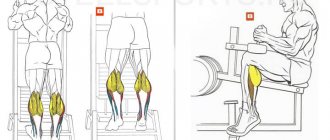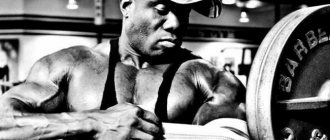Anyone who decides to regularly go to the gym and sets a goal to build a muscular body will probably encounter muscle failure. The phenomenon itself is observed during the training process, when the muscles reach their limit and it becomes impossible to lift the selected weight in compliance with all the requirements of the exercise technique.
You are probably already familiar with performing an exercise to the limit of your capabilities. At the moment when the understanding comes that it will not be possible to lift the weight now if it goes down, muscular failure occurs (the scientific term is “muscular failure”). In this state, the muscles begin to send signals that it will not be possible to lift the weight further, although the brain understands that there is a reserve for 1-2 times.
By the way, many beginners believe that they have already reached this state, but in the first year and a half they rarely achieve “real” failure. It’s very simple - we give in to brain signals that the limit has already been reached, although in fact we can still do 2-3 repetitions. Therefore, in order to find out your limit, try to perform another repetition even when it seems that you can no longer do it.
Is there a need for failure in every approach?
Bodybuilding is an individual sport. This means that while doing it, you will have to find the training method that works best for you. How to do it? Only experimentally, practicing in one style or another for at least a month.
This is why there are bodybuilders who perform every set of an exercise to failure, and there are those who do just one set of failure in each movement.
The main thing to keep in mind is that the number of failure sets should not negatively affect your recovery, either between sessions for the same muscle group, or between workouts in a weekly cycle.
The latter is no less important than the former. After all, during training, not only your muscles get tired, but also your nervous system. If recovery is suffering, try doing fewer failure sets.
“Rejection” training was not invented by Mike Mentzer[edit | edit code]
In fact, the creator of “refusal” training was Arthur Jones - it was his ideas that were subsequently developed and, frankly speaking, brought to the point of absurdity by Mike Mentzer. Jones put forward the idea of refusal training in the early 70s of the last century. A series of his publications in Ironman magazine devoted to “failure” training also served to promote the Nautilus simulators created by Jones on the market. So “failure” training was born as a commercial idea for the “promotion” of a specific product. It was only later that they made a religion out of it.
Do muscles grow from failure?
The great bodybuilder and trainer Mike Mentzer took on the phenomenon of muscle failure in his best-selling book, Supertraining. He believed that this magical, final, failure repetition triggered the process of muscle growth. In general, he was the first person who began to perceive bodybuilding as a science, but that’s not about that now.
I will talk about this in subsequent articles, so, if you wish, you can subscribe to my blog updates so as not to miss anything.
Muscle failure itself does not guarantee muscle growth. I have already said in this article that muscle growth requires only four components, and one of the most important is the progression of the load on the trained muscle.
But! Achieving muscle failure ensures that the muscle has received the load it needs to grow. True, what is also important here is how long the muscle is under load. Failure should occur within 10-20 seconds of starting the set, otherwise the load is likely too low or too high for you.
I won't focus on this now. In this article, my goal is only to introduce you to this phenomenon.
If you can exceed the load of the previous workout without achieving muscle failure, i.e., for example, you did 6 repetitions in the last workout, and there was no failure in the next 9, then you are an athlete with unique genetics, for which I can congratulate you!
This is possible, but practically never happens.
Muscle failure: learning the theory
Everyone who steps into the gym sooner or later encounters the concept of muscle failure. This is not a state when, when you come to the rocking chair after work, you cannot move your arm or leg - it’s just laziness :). Failure manifests itself during the training itself and is expressed in the state of the muscle reaching the limit, i.e. her inability to lift a given weight several more times with correct technique. This is the phenomenon we will talk about.
I think that more than once you have had the opportunity to work at the limit (as you think) of your capabilities during training. Usually this condition is characterized as follows: you do an exercise (let’s say a biceps curl) and at some point you realize that if you lower the dumbbell down now, you definitely won’t be able to pull it up yourself. Sounds familiar, doesn't it? It turns out to be an interesting state when your muscles rebel and no longer want any more load, but the brain understands that the “simulator” (muscle) can still perform one or two body movements. This condition is scientifically called muscle failure or muscular failure.
Note:
I always try to be objective and honest with you in my articles, so I’ll say right away that rarely do beginners reach this state in the first 1-1.5 years of their gym activity. Or rather, they think that they have reached the point where it is no longer possible to work, this is the limit - my plinth. This is far from the case, and the muscle can still freely perform 2-3 working movements, but the brain gives in first, and the person, succumbing to its signals, gives instructions to his body: that’s it - stop “fucking.”
The very phenomenon of muscle failure and training in this kind of style were not in favor before (before the “golden age” of bodybuilding), i.e. Of course, they knew about this phenomenon, but they tried to avoid it like a black cat. The current elite of bodybuilding simply cannot imagine their training and building large muscle volumes without this miraculous method. We will find out who is right and wrong later.
As elsewhere, bodybuilding has its own theories, schools and supporters/opponents of the latter. So, according to one of these schools, the athlete is given the bulk of his weight by relatively light weights and a large number of sets/repetitions. The latter (led by Arthur Jones, the inventor of the Nautilus simulator) unanimously insisted that muscles grow exclusively from critical weights, in a small number of approaches and repetitions.
Proponents of the Jones school believed that it was necessary to “work out” so much that it was impossible to perform even a partial repetition. By the way, this school has a motto: “no pain – no gain”, which literally means “no pain – no growth”. These two camps clashed intensely over who was right and whose concept was more viable and should be considered the one and only. Nowadays, we decided to do something much smarter, simply take it and, with an unbiased (and most importantly, sober) look, summarize all the many years of experience and show how the situation really is.
By the way, this school has a motto: “no pain – no gain”, which literally means “no pain – no growth”. These two camps clashed intensely over who was right and whose concept was more viable and should be considered the one and only. Nowadays, we decided to do something much smarter, simply take it and, with an unbiased (and most importantly, sober) look, summarize all the many years of experience and show how the situation really is.
So, let's go find out.
Muscle failure: postulates
In iron sports, there are two unshakable postulates regarding training with weights and growth factors:
- Any physical activity (not necessarily iron) causes muscle growth;
- The same type of load creates short-term muscle growth.
In practice, this is confirmed by the fact that beginners undergo quite an active transformation in the first 2-3 months of training (overweight people lose weight; ectomorphs gain weight). Those. even the most “clumsy” workouts still lead the muscles to training stress, if only because previously the muscles were simply in a state of “not leaning over.” Having passed this growing area, stupor begins, and all development indicators stop.
The next stage, ideally, should be making fundamental changes to the training, but everything is usually limited to the banal in the form of lifting (increasing the tonnage of the projectile) working weights. As a result, trampling occurs in one place. The main idea that you must understand is that there is no one and only, long-term training program. The meaning of constant progress is to “jump off one train” (read the methods) in time and jump to another. Otherwise, the train will take you to a dead end (stagnation depot).
Therefore, if you want to constantly develop, try and balance between different methods, techniques, schemes - changing large weights to small ones, working to failure, use the principles of Joe Weider. In the time of Arthur Jones, all progress was widely attributed to working to the point of muscle failure. Before we understand the usefulness or unnecessaryness of this method of influencing our muscles and including it in our program, let’s go over the theory.
Scientifically, muscle failure is a condition caused by muscle fatigue (weakness) in the last repetition of a set, in which the athlete is unable to perform a single repetition with correct technique.
Note:
The numerical data says that if you cannot perform 8 “clean” repetitions in a set, then the weight is too heavy. If performed more than 12 times, the weight of the weight is too small. Working in the range of 8-12 reps with a weight of 70% of the maximum (per repetition) gives the most fruitful muscular results to the athlete.
Muscle failure: main types
There are three types of muscle failure:
- positive (concentric) – lifting the projectile;
- negative (eccentric) – lowering the weight;
- static (isometric) – holding the projectile.
You should understand that no matter what exercise you perform, these three phases of working with weights (and, accordingly, three types of failures) will always and everywhere accompany you. You also need to know that concentric force is less than isometric, and it is less than eccentric. In other words, if you are no longer able to lift the projectile up, then you are quite capable of holding it suspended. If you don’t have enough strength here, then you can still lower the projectile smoothly (if you don’t have the strength to lower it, then shout - hey, everyone here! :)).
Complete failure means a state when you have completely exhausted your muscles to the limit, i.e. reached eccentric failure.
These three types of muscle failure are related to muscle fiber types:
- Concentric – affects myofibrils (when lifting weights, the number of muscle myofibrils decreases). It is thanks to myofibrils (when they contract) that muscles increase in circumference. Research has shown that the best results when working with myofibrils can be achieved by working to muscle failure with a weight of 4-6 repetitions;
- Isometric – corresponds to intermediate failure (both types of fibers are involved), when the glycogen depot is depleted and there are no more “fast energy” reserves. Research has shown that the best results (increased muscle strength, size and endurance) when working with this type of failure can be achieved by training with weights of 12-15 repetitions;
- Eccentric - affects mitochondria attached to myofibrils. Mitochondria produce the energy that muscles use to contract and repair themselves. This failure occurs when all possible energy reserves are depleted, but the muscle is not damaged. Contraction stops when lactic acid lactate begins to form. By working in the 20-25 rep range (i.e. fairly light weights but high reps), you will build greater endurance in your muscles.
Well, we got acquainted with a certain theory, now we will move on to practice, or rather...
Muscle failure: pros and cons
Refusal and nervous fatigue
The load on the peripheral and central nervous systems is the main argument of opponents of working to failure, and a very truthful one. After all, after being shaken up by frequent failures, the nervous system will have to take a long time out to recover .
Sometimes the recovery period can take up to 7 days, and during this period, training will not bring anything good. Well, if you continue to train as before, it’s easy to become overtrained and experience a setback in strength and muscle.
As a result, for the sake of several sets to failure, you will have to sacrifice the frequency of training, and frequent training is the basis of progress . But this is just the tip of the iceberg.
Disadvantages of this method
1. Not suitable for home use. After all, a larger number of different exercises requires an equally large amount of different equipment.
2. At the beginning of each such workout, you need to do a good general warm-up. The fact is that with this method you should have almost no warm-up approaches. They can only be in some basic exercises. If you spend time on a warm-up approach for each exercise, this will reduce the effectiveness of the workout and greatly delay it. Therefore, do a good general warm-up at the beginning. And you can also do 1–2 warm-up approaches before each first exercise in a chain of exercises for one muscle group.
For example, you are planning to pump your legs and your first exercise is squats with a barbell. Before this you can do 1-2 warm-up approaches. You need to understand that after squats, your legs are already stretched and there is no need to stretch them before other leg exercises. The same goes for other muscle groups.
3. From the above point it follows that this method is not suitable for beginners. To immediately hang working weights, you must know your working weights very well. That is, they should already thoroughly study your physical capabilities.
4. You must be able to do sets to failure. That is, in such a way that you will not be able to do another repetition under any circumstances. This is a mandatory condition of this method. Without this condition, it loses its effectiveness.
5. You will have to constantly assemble and disassemble the shells after each approach. Not everyone likes it.
What's beyond failure?
Many people wonder how you can move beyond muscle failure, what lies beyond it?! Unfortunately, our body cannot influence failure when our arms refuse not only to lift the barbell, but simply to bend our arms.
But there are several good methods in your arsenal:
Pumping – thanks to which you can take small weights and additionally fill the muscles with blood, causing them to swell before your eyes.
Forced repetitions are a real masochist when you perform a given number of repetitions, and then you are slightly helped at the beginning of the lift by the last 2-3 repetitions, which you lower yourself.
Negative repetitions - when your body refuses to lift the weight at all, they lift it completely for you, you only lower it, concentrating your efforts on the negative phase.
Drop sets - having completed, for example, the planned number of 8 repetitions, reduce the weight by 20-25% and do the same 8 repetitions again and so on until the end, after which your arms will burn and burst, reaching mega failure.
Using these methods of continuing refusal, you just want to shout at the end - “Mom, give me birth back, what am I doing here.”











